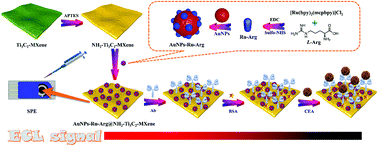Preparation of a disposable electrochemiluminescence sensor chip based on an MXene-loaded ruthenium luminescent agent and its application in the detection of carcinoembryonic antigens
Abstract
Carcinoembryonic antigen (CEA) is an important cancer marker that plays a significant role in achieving low-cost, rapid and highly sensitive clinical detection. In this work, we developed a disposable electrochemiluminescence (ECL) sensor chip based on a screen-printed electrode (SPE) for detecting CEA via ECL technology. An amino-modified Ti3C2 MXene was used as a carrier to successfully prepare a highly efficient ECL probe AuNPs-Ru-Arg@NH2-Ti3C2-MXene by loading with AuNPs-Arg through covalent links and modifying with a ruthenium complex. Upon the addition of CEA, the ECL signal decreased significantly with the increase of CEA, due to the formation of immune complexes at the interface of the electrode. The sensing chip was used to detect CEA in an aqueous solution and found to have a detection limit of 1.5 pg mL−1. The chip was used to determine CEA in the serum of healthy humans and cancer patients, and the results were consistent with those obtained using ELISA. The disposable ECL sensor chip has many advantages including convenience, rapid detection, low cost and easy mass production; thus it has great application potential in clinical cancer diagnosis.



 Please wait while we load your content...
Please wait while we load your content...